An Analysis of Metropolitan Governance and Strategic Planning
VerifiedAdded on 2021/04/21
|9
|1798
|424
Essay
AI Summary
This essay examines metropolitan governance and strategic planning in Australia, focusing on the need for metropolitan-level decision-making to address urban challenges. It evaluates the shift from a manufacturing to a service-based economy and the importance of integrated land use planning. The essay discusses strategic urban planning, its purpose, and the roles of different levels of government. It highlights prevailing justifications, desired characteristics, and limitations of strategic planning, addressing key urban issues such as climate change, biodiversity, and water usage. The governance and political implications of strategic planning are also explored, referencing neo-liberalism and its effects on government actions. The essay emphasizes the importance of strategic planning for creating a sustainable world and managing urban development effectively. The paper discusses the governance and management for principal urban regions of Australia and the major reforms of metropolitan governance. It also evaluates the case of decision making in Australia with effective institutional arrangements for planning of urban development and coordinating the services like infrastructure.
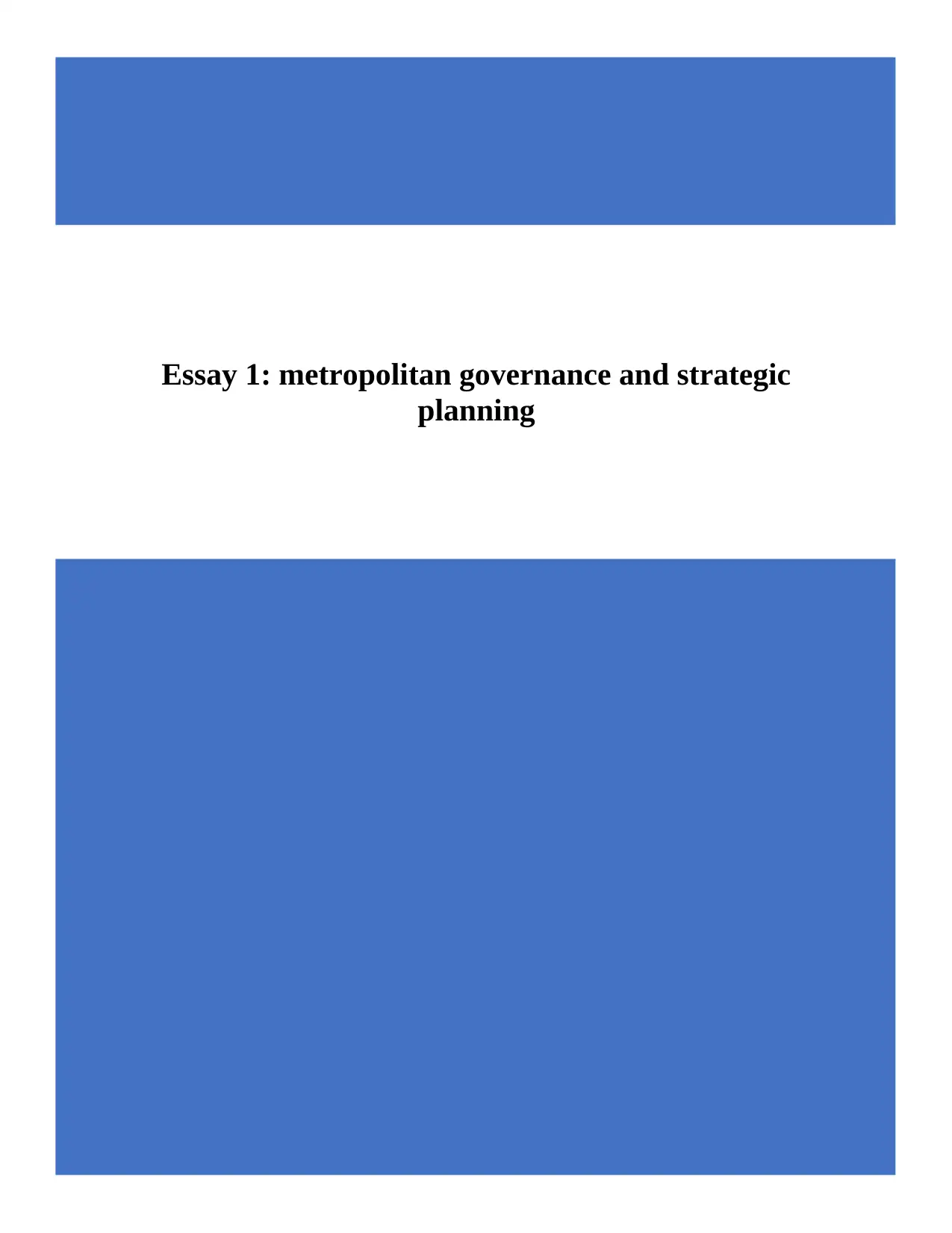
Essay 1: metropolitan governance and strategic
planning
planning
Paraphrase This Document
Need a fresh take? Get an instant paraphrase of this document with our AI Paraphraser
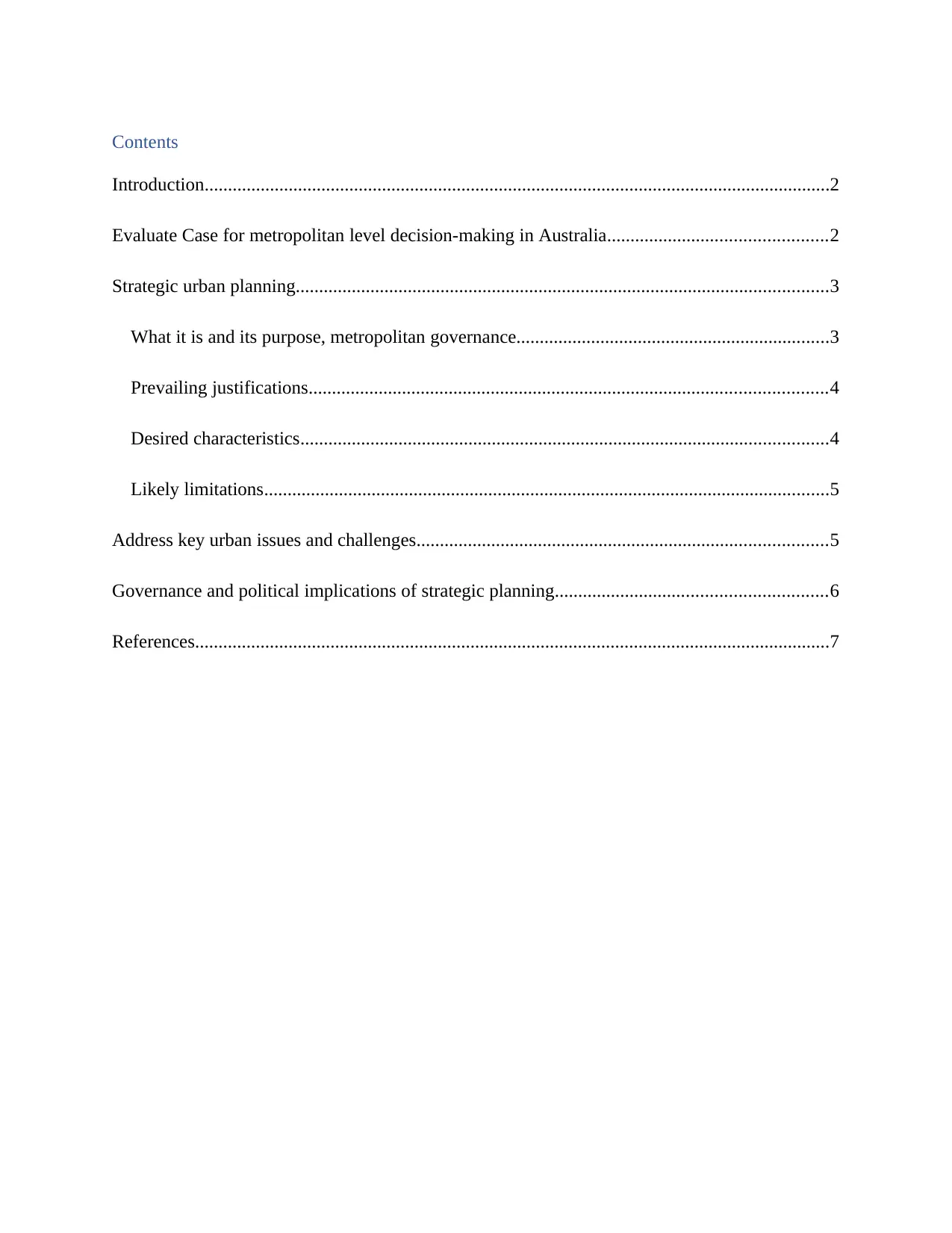
Contents
Introduction......................................................................................................................................2
Evaluate Case for metropolitan level decision-making in Australia...............................................2
Strategic urban planning..................................................................................................................3
What it is and its purpose, metropolitan governance...................................................................3
Prevailing justifications...............................................................................................................4
Desired characteristics.................................................................................................................4
Likely limitations.........................................................................................................................5
Address key urban issues and challenges........................................................................................5
Governance and political implications of strategic planning..........................................................6
References........................................................................................................................................7
Introduction......................................................................................................................................2
Evaluate Case for metropolitan level decision-making in Australia...............................................2
Strategic urban planning..................................................................................................................3
What it is and its purpose, metropolitan governance...................................................................3
Prevailing justifications...............................................................................................................4
Desired characteristics.................................................................................................................4
Likely limitations.........................................................................................................................5
Address key urban issues and challenges........................................................................................5
Governance and political implications of strategic planning..........................................................6
References........................................................................................................................................7
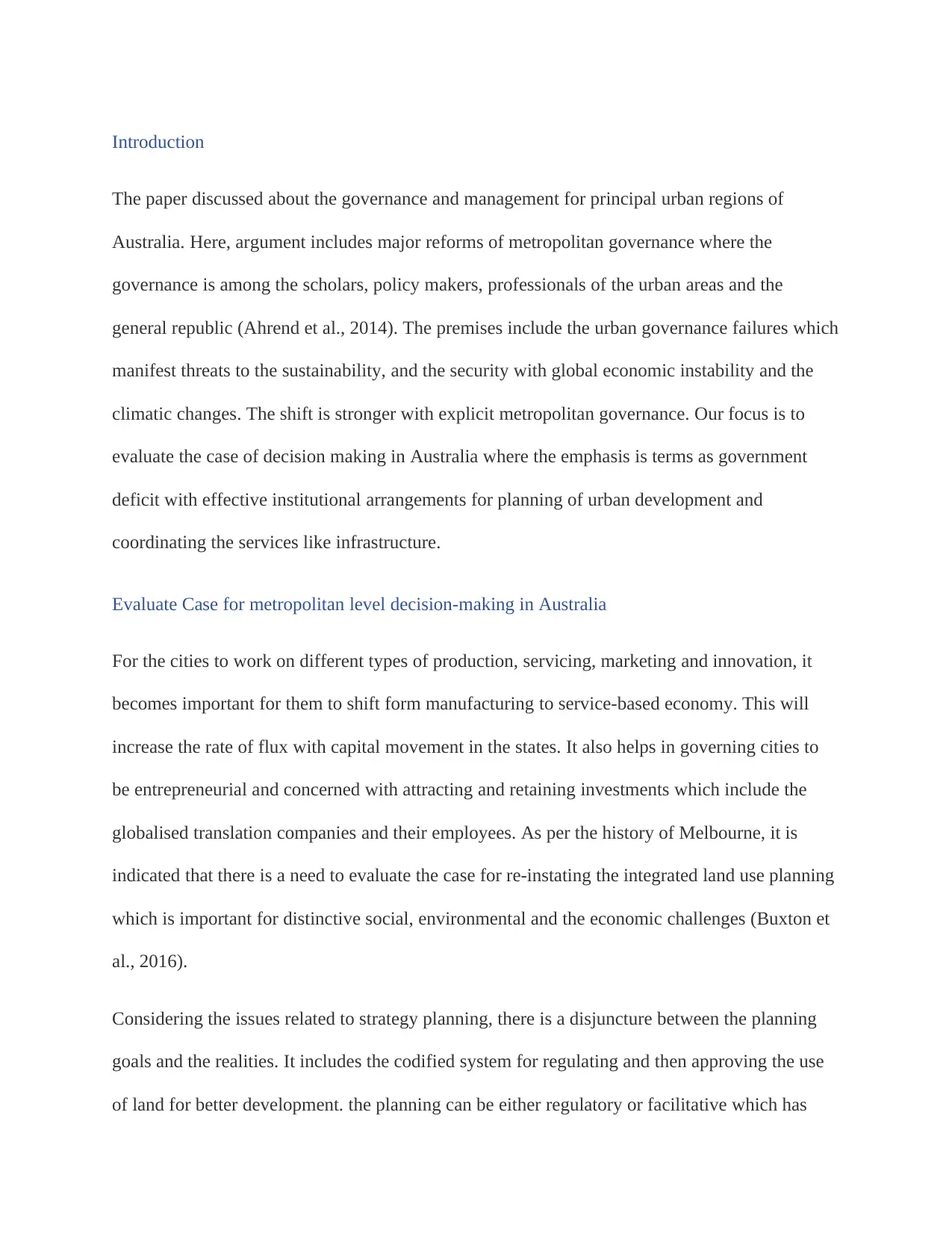
Introduction
The paper discussed about the governance and management for principal urban regions of
Australia. Here, argument includes major reforms of metropolitan governance where the
governance is among the scholars, policy makers, professionals of the urban areas and the
general republic (Ahrend et al., 2014). The premises include the urban governance failures which
manifest threats to the sustainability, and the security with global economic instability and the
climatic changes. The shift is stronger with explicit metropolitan governance. Our focus is to
evaluate the case of decision making in Australia where the emphasis is terms as government
deficit with effective institutional arrangements for planning of urban development and
coordinating the services like infrastructure.
Evaluate Case for metropolitan level decision-making in Australia
For the cities to work on different types of production, servicing, marketing and innovation, it
becomes important for them to shift form manufacturing to service-based economy. This will
increase the rate of flux with capital movement in the states. It also helps in governing cities to
be entrepreneurial and concerned with attracting and retaining investments which include the
globalised translation companies and their employees. As per the history of Melbourne, it is
indicated that there is a need to evaluate the case for re-instating the integrated land use planning
which is important for distinctive social, environmental and the economic challenges (Buxton et
al., 2016).
Considering the issues related to strategy planning, there is a disjuncture between the planning
goals and the realities. It includes the codified system for regulating and then approving the use
of land for better development. the planning can be either regulatory or facilitative which has
The paper discussed about the governance and management for principal urban regions of
Australia. Here, argument includes major reforms of metropolitan governance where the
governance is among the scholars, policy makers, professionals of the urban areas and the
general republic (Ahrend et al., 2014). The premises include the urban governance failures which
manifest threats to the sustainability, and the security with global economic instability and the
climatic changes. The shift is stronger with explicit metropolitan governance. Our focus is to
evaluate the case of decision making in Australia where the emphasis is terms as government
deficit with effective institutional arrangements for planning of urban development and
coordinating the services like infrastructure.
Evaluate Case for metropolitan level decision-making in Australia
For the cities to work on different types of production, servicing, marketing and innovation, it
becomes important for them to shift form manufacturing to service-based economy. This will
increase the rate of flux with capital movement in the states. It also helps in governing cities to
be entrepreneurial and concerned with attracting and retaining investments which include the
globalised translation companies and their employees. As per the history of Melbourne, it is
indicated that there is a need to evaluate the case for re-instating the integrated land use planning
which is important for distinctive social, environmental and the economic challenges (Buxton et
al., 2016).
Considering the issues related to strategy planning, there is a disjuncture between the planning
goals and the realities. It includes the codified system for regulating and then approving the use
of land for better development. the planning can be either regulatory or facilitative which has
⊘ This is a preview!⊘
Do you want full access?
Subscribe today to unlock all pages.

Trusted by 1+ million students worldwide
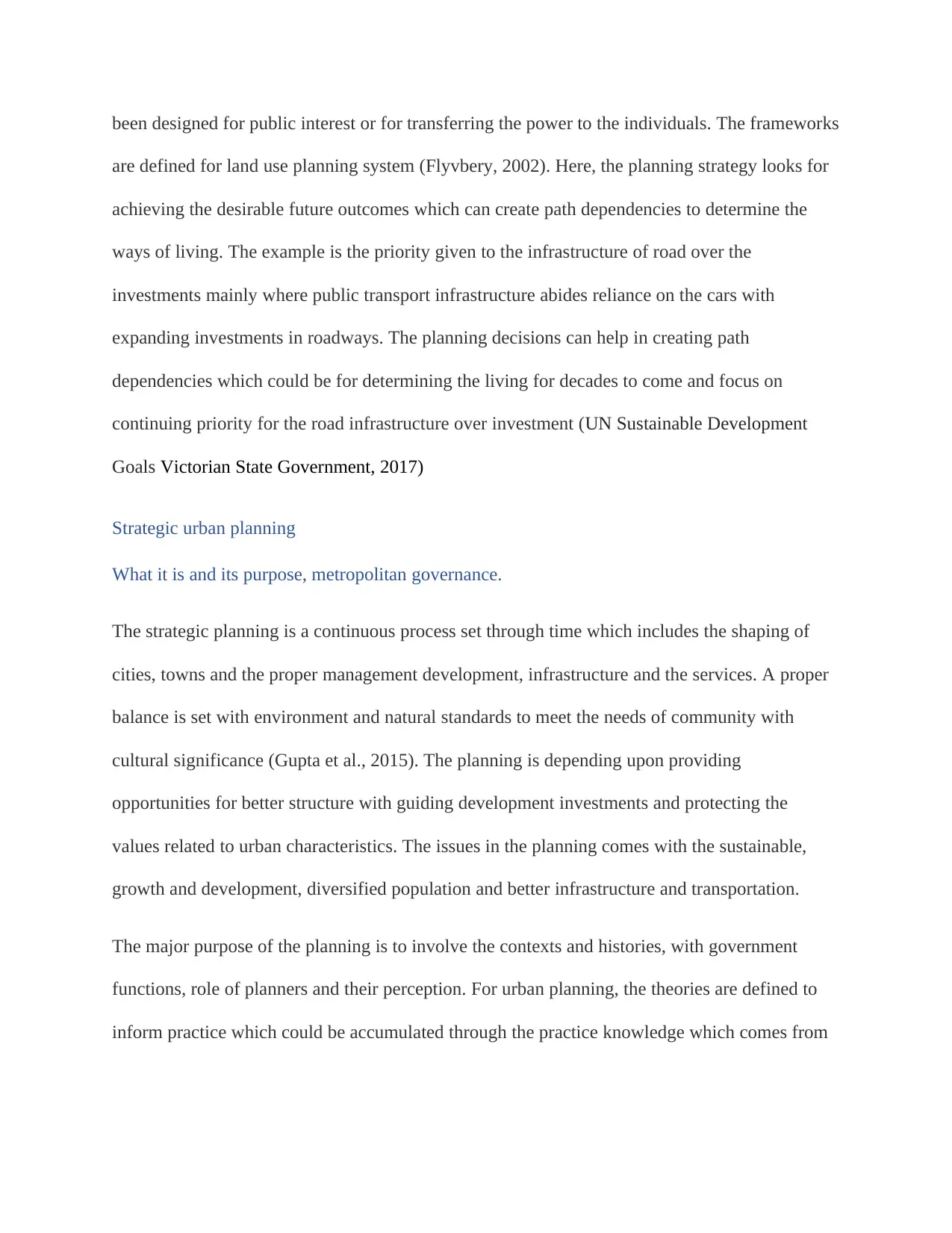
been designed for public interest or for transferring the power to the individuals. The frameworks
are defined for land use planning system (Flyvbery, 2002). Here, the planning strategy looks for
achieving the desirable future outcomes which can create path dependencies to determine the
ways of living. The example is the priority given to the infrastructure of road over the
investments mainly where public transport infrastructure abides reliance on the cars with
expanding investments in roadways. The planning decisions can help in creating path
dependencies which could be for determining the living for decades to come and focus on
continuing priority for the road infrastructure over investment (UN Sustainable Development
Goals Victorian State Government, 2017)
Strategic urban planning
What it is and its purpose, metropolitan governance.
The strategic planning is a continuous process set through time which includes the shaping of
cities, towns and the proper management development, infrastructure and the services. A proper
balance is set with environment and natural standards to meet the needs of community with
cultural significance (Gupta et al., 2015). The planning is depending upon providing
opportunities for better structure with guiding development investments and protecting the
values related to urban characteristics. The issues in the planning comes with the sustainable,
growth and development, diversified population and better infrastructure and transportation.
The major purpose of the planning is to involve the contexts and histories, with government
functions, role of planners and their perception. For urban planning, the theories are defined to
inform practice which could be accumulated through the practice knowledge which comes from
are defined for land use planning system (Flyvbery, 2002). Here, the planning strategy looks for
achieving the desirable future outcomes which can create path dependencies to determine the
ways of living. The example is the priority given to the infrastructure of road over the
investments mainly where public transport infrastructure abides reliance on the cars with
expanding investments in roadways. The planning decisions can help in creating path
dependencies which could be for determining the living for decades to come and focus on
continuing priority for the road infrastructure over investment (UN Sustainable Development
Goals Victorian State Government, 2017)
Strategic urban planning
What it is and its purpose, metropolitan governance.
The strategic planning is a continuous process set through time which includes the shaping of
cities, towns and the proper management development, infrastructure and the services. A proper
balance is set with environment and natural standards to meet the needs of community with
cultural significance (Gupta et al., 2015). The planning is depending upon providing
opportunities for better structure with guiding development investments and protecting the
values related to urban characteristics. The issues in the planning comes with the sustainable,
growth and development, diversified population and better infrastructure and transportation.
The major purpose of the planning is to involve the contexts and histories, with government
functions, role of planners and their perception. For urban planning, the theories are defined to
inform practice which could be accumulated through the practice knowledge which comes from
Paraphrase This Document
Need a fresh take? Get an instant paraphrase of this document with our AI Paraphraser
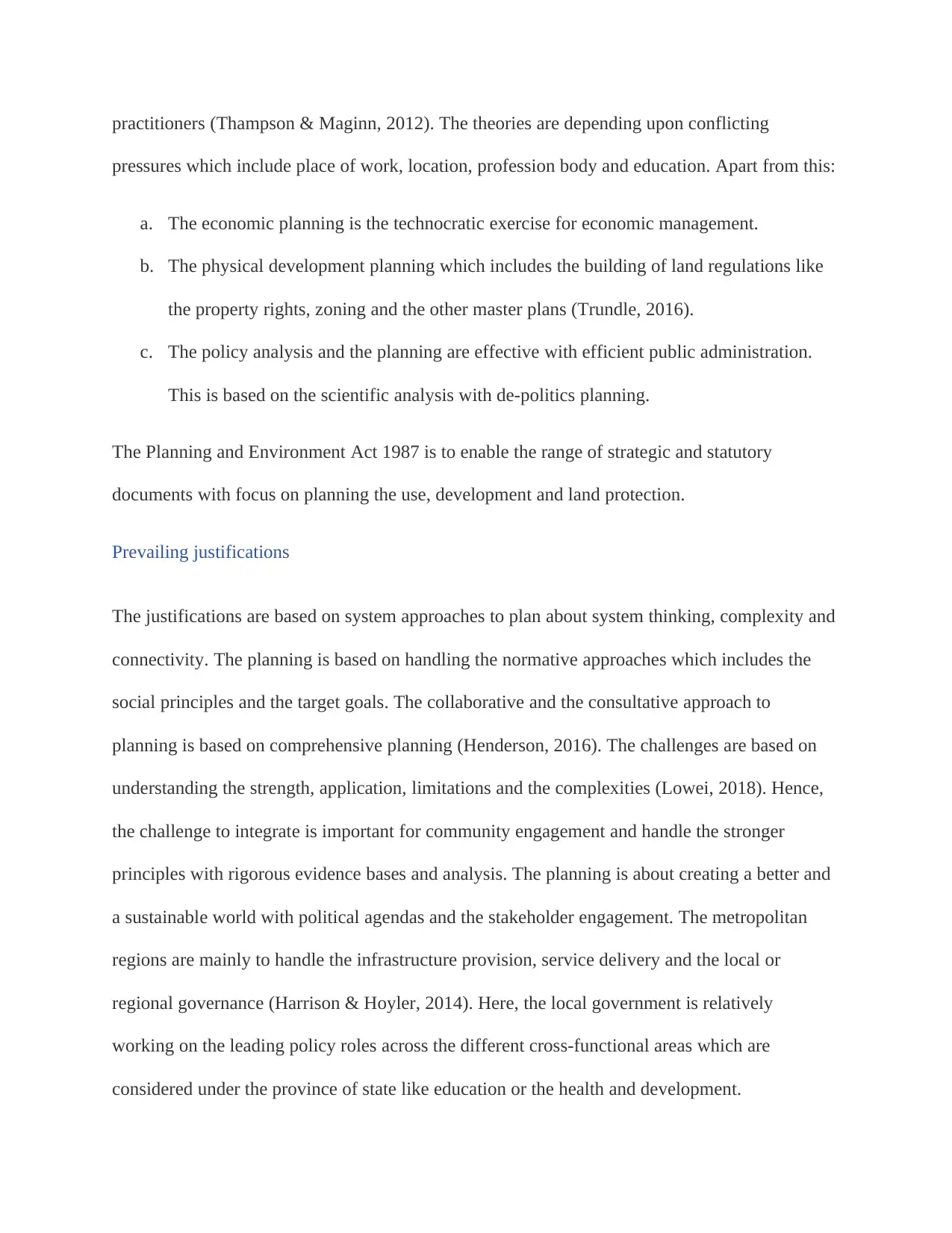
practitioners (Thampson & Maginn, 2012). The theories are depending upon conflicting
pressures which include place of work, location, profession body and education. Apart from this:
a. The economic planning is the technocratic exercise for economic management.
b. The physical development planning which includes the building of land regulations like
the property rights, zoning and the other master plans (Trundle, 2016).
c. The policy analysis and the planning are effective with efficient public administration.
This is based on the scientific analysis with de-politics planning.
The Planning and Environment Act 1987 is to enable the range of strategic and statutory
documents with focus on planning the use, development and land protection.
Prevailing justifications
The justifications are based on system approaches to plan about system thinking, complexity and
connectivity. The planning is based on handling the normative approaches which includes the
social principles and the target goals. The collaborative and the consultative approach to
planning is based on comprehensive planning (Henderson, 2016). The challenges are based on
understanding the strength, application, limitations and the complexities (Lowei, 2018). Hence,
the challenge to integrate is important for community engagement and handle the stronger
principles with rigorous evidence bases and analysis. The planning is about creating a better and
a sustainable world with political agendas and the stakeholder engagement. The metropolitan
regions are mainly to handle the infrastructure provision, service delivery and the local or
regional governance (Harrison & Hoyler, 2014). Here, the local government is relatively
working on the leading policy roles across the different cross-functional areas which are
considered under the province of state like education or the health and development.
pressures which include place of work, location, profession body and education. Apart from this:
a. The economic planning is the technocratic exercise for economic management.
b. The physical development planning which includes the building of land regulations like
the property rights, zoning and the other master plans (Trundle, 2016).
c. The policy analysis and the planning are effective with efficient public administration.
This is based on the scientific analysis with de-politics planning.
The Planning and Environment Act 1987 is to enable the range of strategic and statutory
documents with focus on planning the use, development and land protection.
Prevailing justifications
The justifications are based on system approaches to plan about system thinking, complexity and
connectivity. The planning is based on handling the normative approaches which includes the
social principles and the target goals. The collaborative and the consultative approach to
planning is based on comprehensive planning (Henderson, 2016). The challenges are based on
understanding the strength, application, limitations and the complexities (Lowei, 2018). Hence,
the challenge to integrate is important for community engagement and handle the stronger
principles with rigorous evidence bases and analysis. The planning is about creating a better and
a sustainable world with political agendas and the stakeholder engagement. The metropolitan
regions are mainly to handle the infrastructure provision, service delivery and the local or
regional governance (Harrison & Hoyler, 2014). Here, the local government is relatively
working on the leading policy roles across the different cross-functional areas which are
considered under the province of state like education or the health and development.
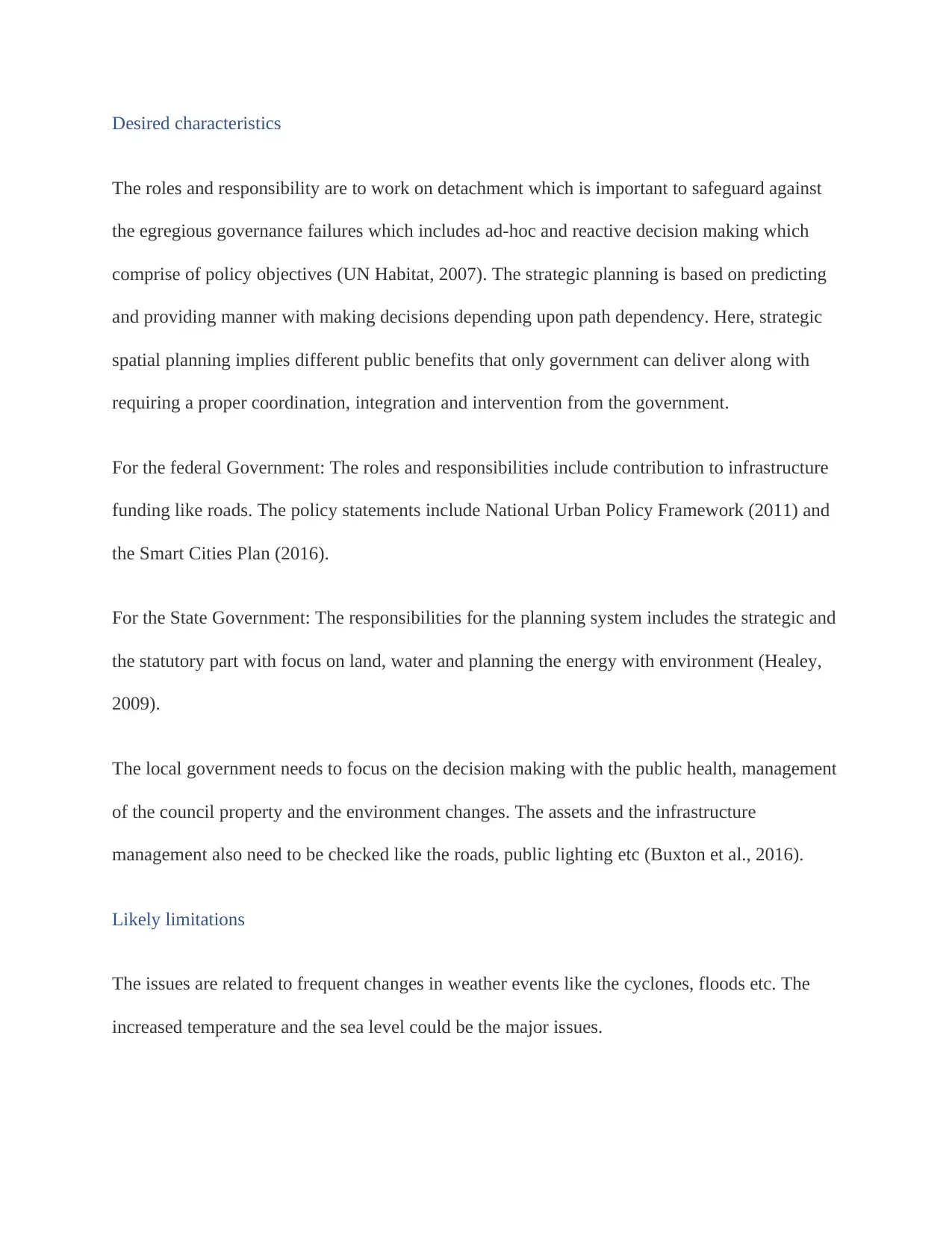
Desired characteristics
The roles and responsibility are to work on detachment which is important to safeguard against
the egregious governance failures which includes ad-hoc and reactive decision making which
comprise of policy objectives (UN Habitat, 2007). The strategic planning is based on predicting
and providing manner with making decisions depending upon path dependency. Here, strategic
spatial planning implies different public benefits that only government can deliver along with
requiring a proper coordination, integration and intervention from the government.
For the federal Government: The roles and responsibilities include contribution to infrastructure
funding like roads. The policy statements include National Urban Policy Framework (2011) and
the Smart Cities Plan (2016).
For the State Government: The responsibilities for the planning system includes the strategic and
the statutory part with focus on land, water and planning the energy with environment (Healey,
2009).
The local government needs to focus on the decision making with the public health, management
of the council property and the environment changes. The assets and the infrastructure
management also need to be checked like the roads, public lighting etc (Buxton et al., 2016).
Likely limitations
The issues are related to frequent changes in weather events like the cyclones, floods etc. The
increased temperature and the sea level could be the major issues.
The roles and responsibility are to work on detachment which is important to safeguard against
the egregious governance failures which includes ad-hoc and reactive decision making which
comprise of policy objectives (UN Habitat, 2007). The strategic planning is based on predicting
and providing manner with making decisions depending upon path dependency. Here, strategic
spatial planning implies different public benefits that only government can deliver along with
requiring a proper coordination, integration and intervention from the government.
For the federal Government: The roles and responsibilities include contribution to infrastructure
funding like roads. The policy statements include National Urban Policy Framework (2011) and
the Smart Cities Plan (2016).
For the State Government: The responsibilities for the planning system includes the strategic and
the statutory part with focus on land, water and planning the energy with environment (Healey,
2009).
The local government needs to focus on the decision making with the public health, management
of the council property and the environment changes. The assets and the infrastructure
management also need to be checked like the roads, public lighting etc (Buxton et al., 2016).
Likely limitations
The issues are related to frequent changes in weather events like the cyclones, floods etc. The
increased temperature and the sea level could be the major issues.
⊘ This is a preview!⊘
Do you want full access?
Subscribe today to unlock all pages.

Trusted by 1+ million students worldwide
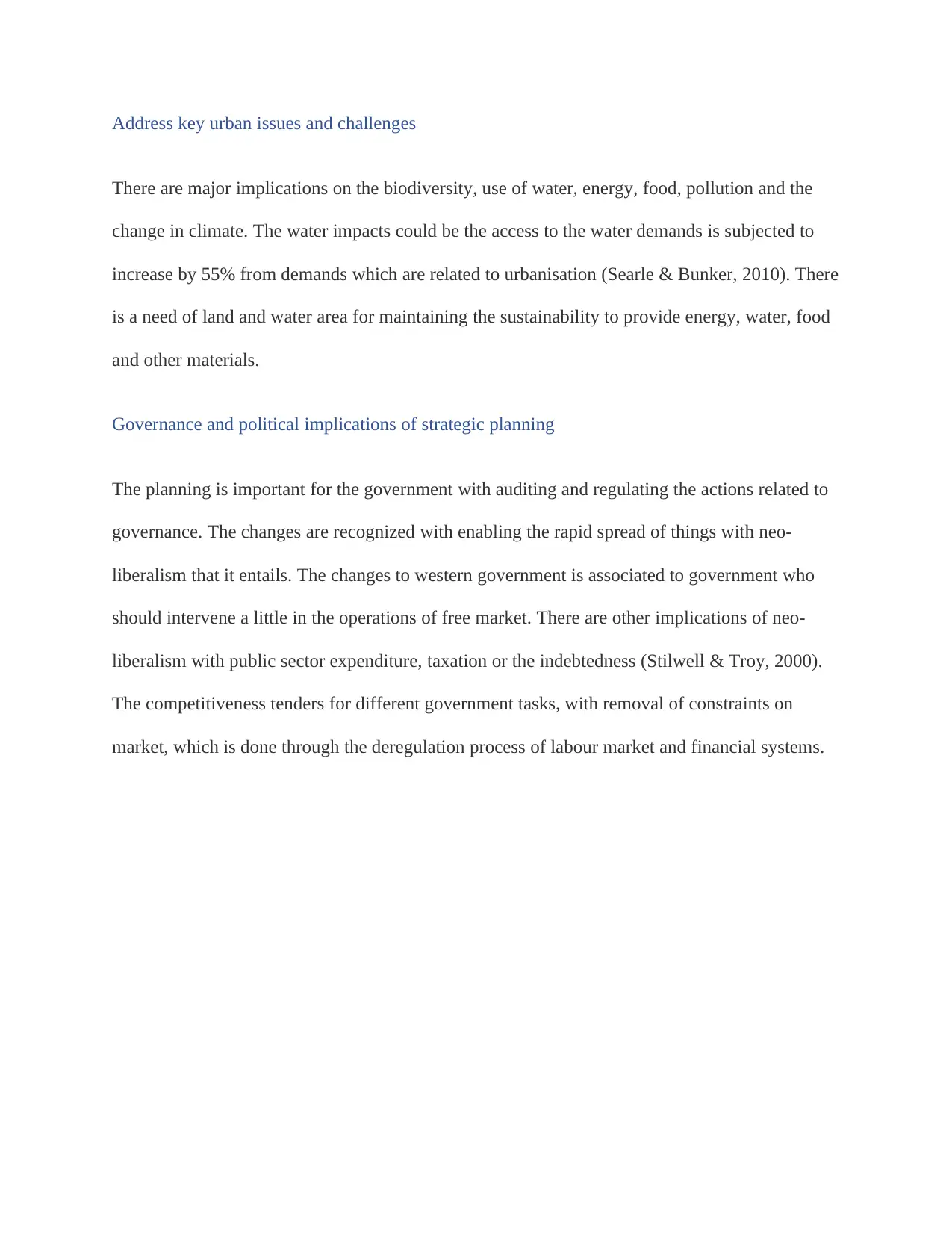
Address key urban issues and challenges
There are major implications on the biodiversity, use of water, energy, food, pollution and the
change in climate. The water impacts could be the access to the water demands is subjected to
increase by 55% from demands which are related to urbanisation (Searle & Bunker, 2010). There
is a need of land and water area for maintaining the sustainability to provide energy, water, food
and other materials.
Governance and political implications of strategic planning
The planning is important for the government with auditing and regulating the actions related to
governance. The changes are recognized with enabling the rapid spread of things with neo-
liberalism that it entails. The changes to western government is associated to government who
should intervene a little in the operations of free market. There are other implications of neo-
liberalism with public sector expenditure, taxation or the indebtedness (Stilwell & Troy, 2000).
The competitiveness tenders for different government tasks, with removal of constraints on
market, which is done through the deregulation process of labour market and financial systems.
There are major implications on the biodiversity, use of water, energy, food, pollution and the
change in climate. The water impacts could be the access to the water demands is subjected to
increase by 55% from demands which are related to urbanisation (Searle & Bunker, 2010). There
is a need of land and water area for maintaining the sustainability to provide energy, water, food
and other materials.
Governance and political implications of strategic planning
The planning is important for the government with auditing and regulating the actions related to
governance. The changes are recognized with enabling the rapid spread of things with neo-
liberalism that it entails. The changes to western government is associated to government who
should intervene a little in the operations of free market. There are other implications of neo-
liberalism with public sector expenditure, taxation or the indebtedness (Stilwell & Troy, 2000).
The competitiveness tenders for different government tasks, with removal of constraints on
market, which is done through the deregulation process of labour market and financial systems.
Paraphrase This Document
Need a fresh take? Get an instant paraphrase of this document with our AI Paraphraser
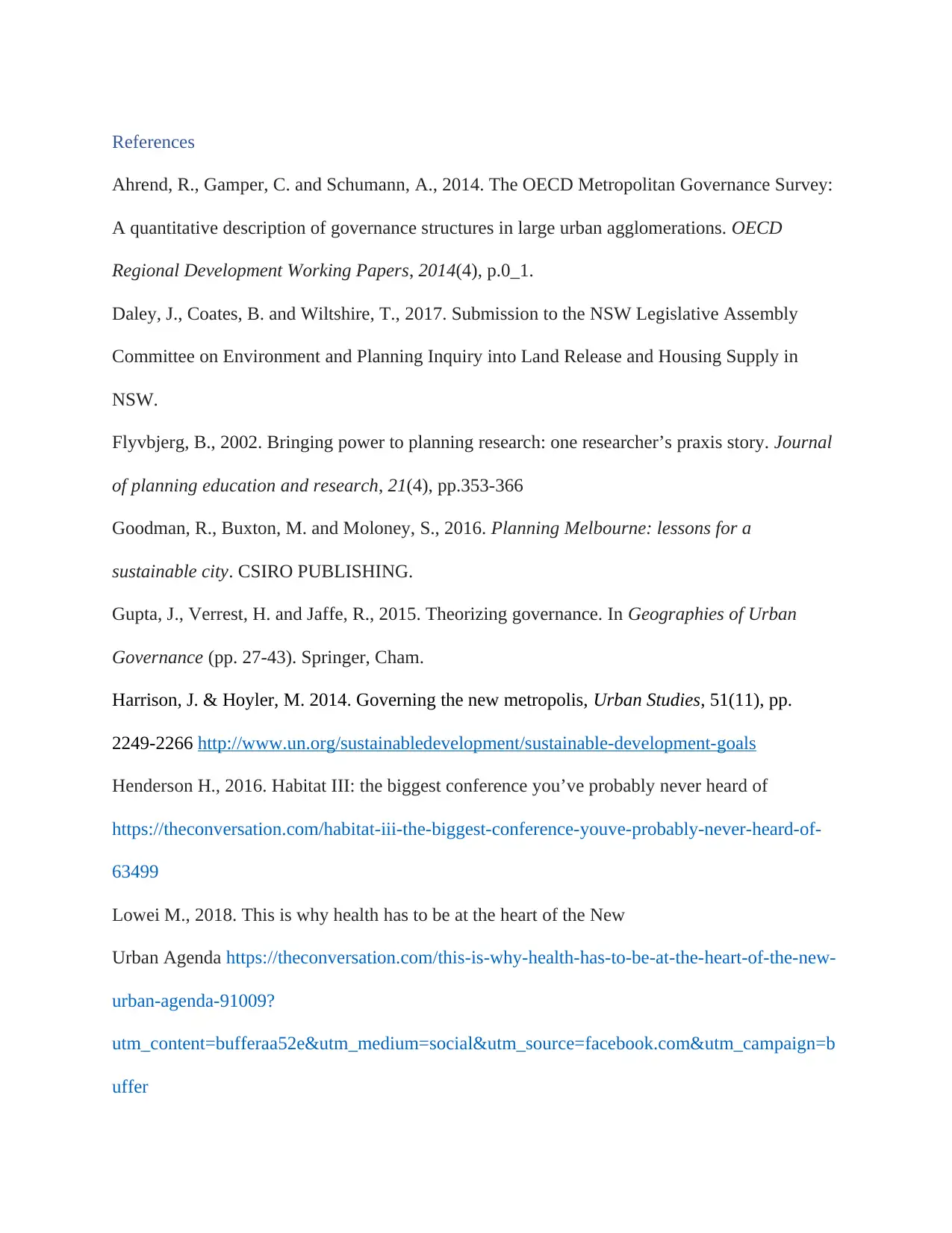
References
Ahrend, R., Gamper, C. and Schumann, A., 2014. The OECD Metropolitan Governance Survey:
A quantitative description of governance structures in large urban agglomerations. OECD
Regional Development Working Papers, 2014(4), p.0_1.
Daley, J., Coates, B. and Wiltshire, T., 2017. Submission to the NSW Legislative Assembly
Committee on Environment and Planning Inquiry into Land Release and Housing Supply in
NSW.
Flyvbjerg, B., 2002. Bringing power to planning research: one researcher’s praxis story. Journal
of planning education and research, 21(4), pp.353-366
Goodman, R., Buxton, M. and Moloney, S., 2016. Planning Melbourne: lessons for a
sustainable city. CSIRO PUBLISHING.
Gupta, J., Verrest, H. and Jaffe, R., 2015. Theorizing governance. In Geographies of Urban
Governance (pp. 27-43). Springer, Cham.
Harrison, J. & Hoyler, M. 2014. Governing the new metropolis, Urban Studies, 51(11), pp.
2249-2266 http://www.un.org/sustainabledevelopment/sustainable-development-goals
Henderson H., 2016. Habitat III: the biggest conference you’ve probably never heard of
https://theconversation.com/habitat-iii-the-biggest-conference-youve-probably-never-heard-of-
63499
Lowei M., 2018. This is why health has to be at the heart of the New
Urban Agenda https://theconversation.com/this-is-why-health-has-to-be-at-the-heart-of-the-new-
urban-agenda-91009?
utm_content=bufferaa52e&utm_medium=social&utm_source=facebook.com&utm_campaign=b
uffer
Ahrend, R., Gamper, C. and Schumann, A., 2014. The OECD Metropolitan Governance Survey:
A quantitative description of governance structures in large urban agglomerations. OECD
Regional Development Working Papers, 2014(4), p.0_1.
Daley, J., Coates, B. and Wiltshire, T., 2017. Submission to the NSW Legislative Assembly
Committee on Environment and Planning Inquiry into Land Release and Housing Supply in
NSW.
Flyvbjerg, B., 2002. Bringing power to planning research: one researcher’s praxis story. Journal
of planning education and research, 21(4), pp.353-366
Goodman, R., Buxton, M. and Moloney, S., 2016. Planning Melbourne: lessons for a
sustainable city. CSIRO PUBLISHING.
Gupta, J., Verrest, H. and Jaffe, R., 2015. Theorizing governance. In Geographies of Urban
Governance (pp. 27-43). Springer, Cham.
Harrison, J. & Hoyler, M. 2014. Governing the new metropolis, Urban Studies, 51(11), pp.
2249-2266 http://www.un.org/sustainabledevelopment/sustainable-development-goals
Henderson H., 2016. Habitat III: the biggest conference you’ve probably never heard of
https://theconversation.com/habitat-iii-the-biggest-conference-youve-probably-never-heard-of-
63499
Lowei M., 2018. This is why health has to be at the heart of the New
Urban Agenda https://theconversation.com/this-is-why-health-has-to-be-at-the-heart-of-the-new-
urban-agenda-91009?
utm_content=bufferaa52e&utm_medium=social&utm_source=facebook.com&utm_campaign=b
uffer
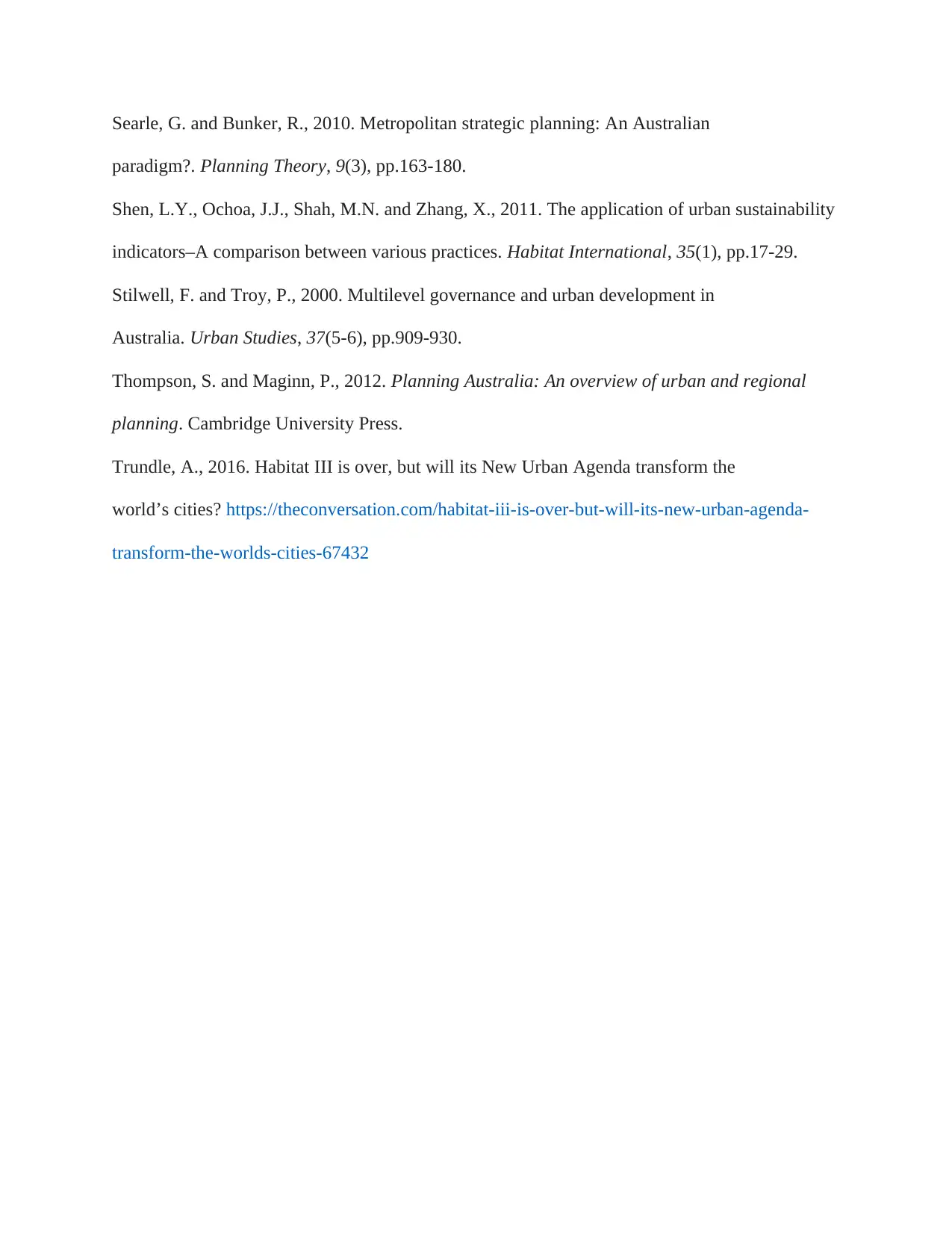
Searle, G. and Bunker, R., 2010. Metropolitan strategic planning: An Australian
paradigm?. Planning Theory, 9(3), pp.163-180.
Shen, L.Y., Ochoa, J.J., Shah, M.N. and Zhang, X., 2011. The application of urban sustainability
indicators–A comparison between various practices. Habitat International, 35(1), pp.17-29.
Stilwell, F. and Troy, P., 2000. Multilevel governance and urban development in
Australia. Urban Studies, 37(5-6), pp.909-930.
Thompson, S. and Maginn, P., 2012. Planning Australia: An overview of urban and regional
planning. Cambridge University Press.
Trundle, A., 2016. Habitat III is over, but will its New Urban Agenda transform the
world’s cities? https://theconversation.com/habitat-iii-is-over-but-will-its-new-urban-agenda-
transform-the-worlds-cities-67432
paradigm?. Planning Theory, 9(3), pp.163-180.
Shen, L.Y., Ochoa, J.J., Shah, M.N. and Zhang, X., 2011. The application of urban sustainability
indicators–A comparison between various practices. Habitat International, 35(1), pp.17-29.
Stilwell, F. and Troy, P., 2000. Multilevel governance and urban development in
Australia. Urban Studies, 37(5-6), pp.909-930.
Thompson, S. and Maginn, P., 2012. Planning Australia: An overview of urban and regional
planning. Cambridge University Press.
Trundle, A., 2016. Habitat III is over, but will its New Urban Agenda transform the
world’s cities? https://theconversation.com/habitat-iii-is-over-but-will-its-new-urban-agenda-
transform-the-worlds-cities-67432
⊘ This is a preview!⊘
Do you want full access?
Subscribe today to unlock all pages.

Trusted by 1+ million students worldwide
1 out of 9
Related Documents
Your All-in-One AI-Powered Toolkit for Academic Success.
+13062052269
info@desklib.com
Available 24*7 on WhatsApp / Email
![[object Object]](/_next/static/media/star-bottom.7253800d.svg)
Unlock your academic potential
Copyright © 2020–2025 A2Z Services. All Rights Reserved. Developed and managed by ZUCOL.





